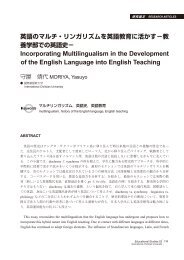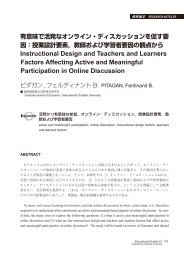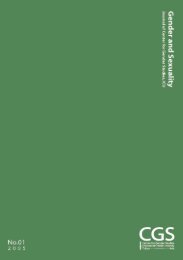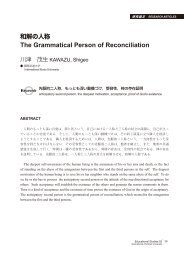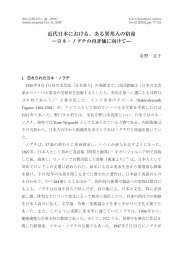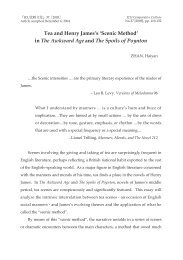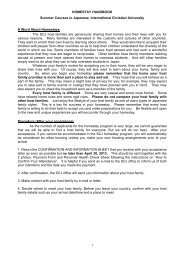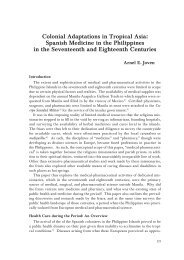Sign Language Variation and Implications for Deaf Education in Japan
Sign Language Variation and Implications for Deaf Education in Japan
Sign Language Variation and Implications for Deaf Education in Japan
You also want an ePaper? Increase the reach of your titles
YUMPU automatically turns print PDFs into web optimized ePapers that Google loves.
listed. The advantages of us<strong>in</strong>g ‘shuwa’ are that it is<br />
very expressive <strong>and</strong> can help early communication<br />
between mother <strong>and</strong> child. Also learn<strong>in</strong>g ‘shuwa’<br />
can raise the self-esteem of the students <strong>and</strong> raise<br />
their pride <strong>in</strong> be<strong>in</strong>g <strong>Deaf</strong>. S<strong>in</strong>ce ‘shuwa’ is used <strong>in</strong><br />
a broad sense here, the use of ‘shuwa’ as a <strong>for</strong>m of<br />
Total Communication (an eclectic method allow<strong>in</strong>g<br />
all types of communication modes to achieve<br />
efficient communication) is considered as an<br />
advantage. On the other h<strong>and</strong>, they state that one of<br />
the disadvantages of ‘shuwa’ is that it cannot show<br />
<strong>Japan</strong>ese sounds <strong>and</strong> does not have a written <strong>for</strong>m.<br />
Other disadvantages are limitations of vocabulary<br />
<strong>and</strong> limitation when communicat<strong>in</strong>g with hear<strong>in</strong>g<br />
people (as not everyone can use ‘shuwa’). This<br />
typically shows that the f<strong>in</strong>al aim <strong>for</strong> deaf students is<br />
to <strong>in</strong>tegrate with the hear<strong>in</strong>g.<br />
Chuuou <strong>Deaf</strong> School has a junior high <strong>and</strong> high<br />
school <strong>and</strong> does not specify <strong>in</strong> their objectives the<br />
use of sign language but <strong>in</strong>dicates as their goal,<br />
the cultivation of communication <strong>and</strong> expressive<br />
skills that will help deaf students to enter university.<br />
What this ‘communication skill’ encompasses<br />
rema<strong>in</strong>s unclear but is most likely to be <strong>Japan</strong>ese<br />
rather than sign language. In the ‘Address by the<br />
Pr<strong>in</strong>cipal’, ‘shuwa’ is considered to provide access<br />
to <strong>in</strong><strong>for</strong>mation along with note-tak<strong>in</strong>g <strong>and</strong> is thereby<br />
useful as a secondary tool to develop deaf students’<br />
knowledge of the world.<br />
Tachikawa <strong>Deaf</strong> School with k<strong>in</strong>dergarten to high<br />
school sections does not state specific educational<br />
goals on their homepage. Goals related to language<br />
are only referred to <strong>in</strong> junior high, stat<strong>in</strong>g that they<br />
aim <strong>for</strong> students who can underst<strong>and</strong> their disability<br />
<strong>and</strong> overcome it with language <strong>and</strong> learn<strong>in</strong>g skills.<br />
‘<strong>Language</strong>’ seems to be used <strong>in</strong> a very general term<br />
similar to the word ‘kotoba’ used by the Ootsuka<br />
<strong>Deaf</strong> School. The implication aga<strong>in</strong> po<strong>in</strong>ts towards<br />
the acquisition of the oral rather than the visual<br />
language.<br />
Katsushika <strong>Deaf</strong> School with k<strong>in</strong>dergarten to<br />
high school sections also does not use the term<br />
‘shuwa’ but clearly states <strong>for</strong> their primary school<br />
that their goal is to develop communication skills<br />
<strong>and</strong> <strong>Japan</strong>ese ability. They add though that they<br />
support the use of ‘shuwa’ to decrease <strong>in</strong><strong>for</strong>mation<br />
deficiency. Thus ‘shuwa’ aga<strong>in</strong> plays a secondary<br />
role as at the Chuuou <strong>Deaf</strong> School.<br />
Look<strong>in</strong>g at the educational objectives of<br />
public deaf schools <strong>in</strong> Tokyo, the term ‘shuwa’ is<br />
surpris<strong>in</strong>gly used less frequently than expected<br />
<strong>and</strong> detailed educational methods are not stated.<br />
Kanazawa (2001) po<strong>in</strong>ts out that many people often<br />
use the term ‘Kouwa hou’ <strong>for</strong> the Oral Method <strong>and</strong><br />
‘Shuwa hou’ <strong>for</strong> the <strong>Sign</strong> <strong>Language</strong> Method without<br />
clearly def<strong>in</strong><strong>in</strong>g each method. Some people may<br />
use ‘Shuwa hou’ to refer to the use of some signs<br />
to supplement speech while others may consider<br />
‘Shuwa hou’ to refer to teach<strong>in</strong>g all classes <strong>in</strong> JSL. In<br />
<strong>Japan</strong>, us<strong>in</strong>g some signs to supplement speech dur<strong>in</strong>g<br />
the early development phase (a so-called ‘Shuwahou’)<br />
is sometimes considered only as a <strong>for</strong>m of<br />
communication rather than of language as can be<br />
<strong>in</strong>ferred from the school goals. Kanazawa (2001)<br />
<strong>in</strong>dicates that sometimes, ‘Shuwa-hou’ is considered<br />
to support ‘Kouwa-hou’. That is, children learn how<br />
to communicate <strong>in</strong> the early years us<strong>in</strong>g some signs<br />
but are slowly shifted towards the use of spoken<br />
language.<br />
In the past, the use of ‘shuwa’ has been prohibited<br />
<strong>in</strong> the deaf schools but students are now allowed to<br />
sign <strong>in</strong> schools. The current problem <strong>in</strong> the schools<br />
is that most teachers of the deaf are hear<strong>in</strong>g <strong>and</strong> have<br />
hardly any background tra<strong>in</strong><strong>in</strong>g <strong>in</strong> deaf education.<br />
Sasaki (2006) has a strong view that most teachers at<br />
public deaf schools use ‘Taiou Shuwa’ <strong>and</strong> this type<br />
of sign<strong>in</strong>g is not useful <strong>for</strong> the language development<br />
of the deaf. Sasaki expla<strong>in</strong>s that teachers do not<br />
have enough time to acquire sign language <strong>and</strong> the<br />
rotation system prevents teachers from stay<strong>in</strong>g at<br />
deaf schools long enough to master how to teach the<br />
deaf. Ueno (2003) categorized two types of sign<strong>in</strong>g<br />
196<br />
<strong>Education</strong>al Studies 52<br />
International Christian University



